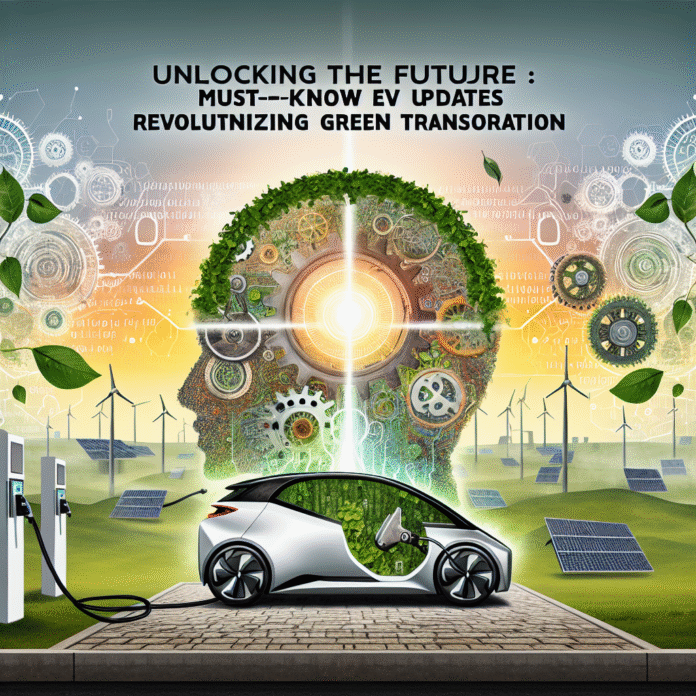Unlocking the Future: Must-Know EV Updates Revolutionizing Green Transportation
Imagine a world where your daily commute not only gets you to work but also helps save the planet. Sounds like a dream, right? Well, with the rapid advancements in electric vehicles (EVs), that dream is becoming a reality. In fact, global EV sales surged to over 10 million units in 2022 alone, a clear signal that consumers are shifting gears toward greener options. The future of transportation is not just electric; it’s revolutionized. If you’re a tech enthusiast or simply someone curious about sustainable living, buckle up as we explore the latest updates and innovations in the EV world that are transforming green transportation.
Charging Ahead: The Rise of Fast Charging Technology
One of the most significant barriers to widespread EV adoption has been the time it takes to recharge. Long gone are the days when charging an EV would take hours—new fast-charging technologies are changing the game. The latest advancements now allow drivers to power up their vehicles in a fraction of the time.
For instance, Tesla has rolled out V3 Superchargers, capable of delivering up to 250 kW, providing up to 75 miles of range in just 5 minutes. Similarly, companies like Ionity are setting up charging stations across Europe that can recharge vehicles in as little as 18 minutes. Imagine stopping for coffee and leaving with a full battery. The convenience factor is soaring, making EVs more attractive than ever.
Battery Innovations: A New Era of Efficiency
Battery technology is at the heart of the EV revolution. Traditional lithium-ion batteries have served their purpose, but the industry is shifting towards newer chemistries that promise increased energy densities and reduced costs. Solid-state batteries, for example, are garnering a lot of attention.
- Safety: Less flammable than traditional batteries.
- Longevity: Longer lifespan, meaning you won’t need to replace them as often.
- Efficiency: Higher energy capacity, allowing for longer ranges on a single charge.
Companies like QuantumScape and Toyota are making strides in solid-state technology, with projections suggesting we could see these batteries in consumer EVs within the next few years. If successful, this could mean a dramatic increase in range and performance for electric cars, appealing even to those skeptical about switching from gasoline to electric.
Autonomous Driving: The Future of Mobility
The concept of self-driving vehicles is often met with intrigue and skepticism. The prospect of hitting the road without lifting a finger is tantalizing but still appears to be years away for widespread use. However, fundamental advancements are being made that could soon make this a reality.
Imagine being able to lounge in the back seat while your car navigates through traffic or finds the nearest charging station. Companies like Waymo and Tesla are pushing the envelope on autonomous driving technology, testing their systems on urban streets and rural roads alike. With every iteration, AI algorithms learn how to better predict and respond to various driving conditions, increasing both safety and convenience.
In practical terms, this means less stress during rush hour. You could even use your commute to catch up on emails or enjoy a podcast. It’s a glimpse into a future where you don’t just drive your car; your car drives you.
Regulatory Support: Government Policies Driving Change
The push towards electric vehicles isn’t just a consumer trend; it’s backed by solid regulatory frameworks that encourage the adoption of green technologies. Various governments worldwide are implementing incentives aimed at both consumers and manufacturers. In the U.S., for instance, the federal government offers tax credits for EV buyers, while China’s policies have made it the largest EV market globally.
Moreover, many cities are enforcing stricter emissions regulations, making it less appealing for consumers to stick with traditional internal combustion engine (ICE) vehicles. Cities like Amsterdam and Oslo plan to ban gasoline and diesel cars altogether in the coming years, pushing even more residents to consider electric alternatives.
Real-World Use Cases: EVs in Action
So what does all this mean in the real world? Take last-mile delivery services as an example. Companies like Amazon and UPS are rolling out electric delivery vans, significantly reducing carbon footprints. Amazon aims to have 100,000 electric delivery vans on the road by 2030, revolutionizing logistics while benefiting the environment.
Beyond logistics, public transportation is also undergoing electrification. Electric buses are becoming more prevalent in cities worldwide. They reduce air pollution and noise, creating a more pleasant urban environment. Imagine riding a bus that’s not only efficient but also helps contribute to cleaner air in your city. Sounds appealing, doesn’t it?
The Social Shift: Changing Mindsets Toward EVs
The final piece of this puzzle is a shift in social attitudes toward electric vehicles. As more people become aware of the environmental impacts of traditional vehicles, consumer demand for EVs is rising. Social media campaigns, influencer endorsements, and community initiatives play significant roles in changing perceptions.
There’s also a growing community of EV owners who passionately share their positive experiences, debunking myths and misconceptions about electric vehicles. It’s like a grassroots movement, where knowledge is being traded, and the community is paving the way for a greener future. As more people understand the benefits, from cost savings to reducing greenhouse gas emissions, the EV market is expected to continue booming.
Looking Ahead: The Road of Innovation
The future of transportation is undeniably electric, filled with innovation, efficiency, and sustainability. From rapid charging solutions to groundbreaking advancements in battery and autonomous technologies, the EV landscape is evolving rapidly, making electric vehicles more accessible and appealing than ever.
As the world steers toward greener alternatives, one thing is clear: the shift has just begun. Whether you’re a skeptic or a devoted EV enthusiast, it’s time to embrace this change. After all, the road to sustainability is a road worth traveling, and electric vehicles are paving the way.

